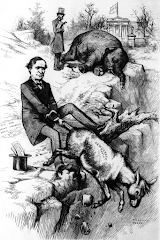The Association of American Editorial Cartoonists (AAEC)
By: Grace Weisenfield and Reece Harnett
Mission Statement
The Association of American Editorial Cartoonists was established in 1957 by John Stampone and several other newspaper cartoonists. There are several objectives of The Association of American Editorial Cartoonists.
One objective is to promote editorial cartooning and the artistic expression of politics from a range of platforms. Editorial cartooning correlates with freedom of speech and freedom of the press, as it allows journalists to excercise their liberties to speak freely about the government without any repercussions.
Photo from: editorialcartoonists.com
Furthermore, freedom of the press permits editorial cartooning and political art because citizens depend on the media to keep them abreast on government activity, as well as other significant matters. Secondly, AAEC strives to serve as a national and international example of how to promote political cartooning that is protected under the freedom of speech clause.
By doing so, this opens the door for young aspiring journalists and editorialists to showcase their creativity and talents while also exploring the different dimensions of political cartoons.
History of Political Cartoons-Thomas Nast
Thomas Nast is remembered as one of the most prominent cartoonists in American history. During his 24-year tenure at Harper's Weekly, he was most notable for his works pertaining to the Civil War, Reconstruction Era, race relations/racism, and politics.
Photo from: cnn.com
During the 1874 midterm elections, the New York Herald publicized that then President Ulysses Grant had considered seeking re-election a third time, which was a scandalous endeavor during this era.
Nast, however, was not at all shy about expressing his support for the Republican Party. He also used his cartoons as a mechanism to illustrate political polaraization between the Democratic and Republican parties.
Photo from: cnn.com
For example, one of his political cartoons depicts the New York Herald as a donkey arousing fear of American democracy under the Grant administration. Another one of Nast's cartoons portrays the Republican party (elephants) as fragile, inferior and venturing down a destructive path.
Photo from: cnn.com
Importance of Cartoons in Journalism
Cartoons are vital in Journalism, especially in today's political climate. First of all, they are designed to highlight commentaries on social, political and economic matters that editors might not be permitted to dislose. Journalists and editors are expected to remain neutral when covering politics, as it is intertwined with ethical values. It is also sometimes hard to trust reporters and editors on political issues without knowing where they stand on the political spectrum. Political cartoons, therefore allow readers to interrelate more with cartoonists in the sense that they are able to view current events from the cartoonist's perspective.
My perspective
I personally believe political cartoons are beneficial for younger audiences, as it incentivizes them to read the news and follow politics. When I was growing up, it was rare to encounter other people my age who read the news, whether in print or digital form.
It is imperative that we as U.S. citizens educate ourselves about what is going on in our society because it affects our lives on a daily basis. Political cartoons are also conducive in helping younger audiences think for themselves and formulate their own political ideologies.
Most of the time, children inevitably adopt the same political beliefs as their parents and peers because it is all they know. Studying political and social matters from another person's point of view, espcially in cartoons, forces readers to think critically and see matters from both sides.
I am a stong advocate for critical thinking, as it is something I am still working towards myself. When I was younger, I had a horrible habit of allowing other people to think for me because I was so insecure that I did not feel my opinions and feelings mattered.
Over the years, I have become more confident in my own philosophies, but I'm still trying to work on not allowing others to force their views on to me. We should not always accept what others say or believe without comprehending it on our own to determine whether it makes sense and if it is true.
I am beginning to consider myself as more of a maverick because I am less afraid to challenge the status quo and things that my parents and peers believe. I don't feel any shame in admitting this either, as I am my own person, and I know that just because I view something differently does not mean that I am wrong.
My favorite political cartoon
One of my most favorite politcal cartoons is the 2016 cartoon of former Alaska Gov. Sarah Palin endorsing former President Donald Trump in Iowa. I like this cartoon because it accurately reflects the whole dynamic of the video.
Sarah Palin was very incoherent during her entire speech and did not appear knowledgeable on anything she was talking about. I vividly remember listening to her speech over and over again and trying to understand her better each time, but I could not.
Judging by Donald Trump's facial expressions during parts of the video, it appeared that he was even unclear as to where she was coming from with what she was saying. I love looking at this cartoon whenever I need a good laugh because it is honestly hysterical.
Photo from: usnews.com
Sarah Palin endorsing Donald Trump-video link: https://www.youtube.com/watch?v=Mvlm3LKSlpU
https://editorialcartoonists.com/about-the-association-of-american-editorial-cartoonists/









No comments:
Post a Comment